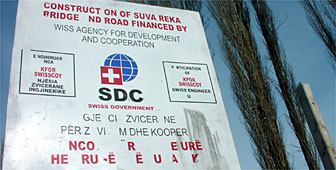
How Switzerland got involved with Kosovo

The conflict in Kosovo has historic roots: rivalries between Serbs and Albanians for control of the region date back to the 14th century.
The province was incorporated into Serbia in 1912 and later into Yugoslavia; until 1989, it enjoyed relative autonomy.
Then Belgrade imposed a regime that excluded Albanian speakers from Kosovo’s key administrative and economic sectors. In response to the Serbian army’s occupation of the province, the Kosovo Liberation Army (KLA) was organized — it waged a 15-month guerrilla campaign against Serb rule.
Conflict worsens
In early 1998, large-scale fighting broke out in the province, resulting in the displacement of some 300,000 people. A ceasefire was agreed in October, 1998, which enabled refugees to find shelter, averting an impending humanitarian crisis over the winter.
A Verification Mission was deployed under the auspices of the Organisation for Security and Cooperation in Europe (OSCE) in which Switzerland took part.
Despite the presence of observers, violence continued and the situation worsened significantly in January, 1999.
Yugoslav military, paramilitary and police forces mounted a systematic, violent campaign against Kosovo’s ethnic Albanians.
A peace conference, held in Paris in mid-March, broke up with the refusal of the Yugoslav delegation to accept a peaceful settlement.
NATO strikes
On March 24, 1999, NATO forces began air operations over the Federal Republic of Yugoslavia in an attempt to resolve the Kosovo crisis.
The campaign was not sanctioned by the UN Security Council, since Russia and China strongly opposed the intervention.
Milosevic capitulates
On June 3, President Slobodan Milosevic finally accepted peace terms presented by the EU envoy, president Martti Ahtisaari and the Russian envoy, Viktor Chernomyrdin.
With the authorisation of the UN (Resolution 1244), NATO and Russian forces were deployed to Kosovo to begin the task of restoring peace to the province.
By June 20, all Serb forces had left Kosovo, and security matters in the province had passed into the hands of KFOR, the international peacekeeping force.
Swiss involvement
On June 23, 1999, the Swiss government decided to take part in the peace-keeping operation.
The UN Interim Administration in Kosovo (UNMIK) took over the task of governing the province.
Swiss participation in Operation Joint Guardian was seen as part of the policy to deal with the refugee problem in Switzerland and to organise immediate help in Kosovo.
Swiss Company, or Swisscoy, was made up of 160 mostly unarmed volunteers. They were sent to provide logistical support to the Austrian battalion (AUCON), and established their camp on the premises of a former rubber factory on the outskirts of Suva Reka (between Prizren and Pristina).
Swisscoy provides transport for goods and people, water processing and supply, medical help and engineering services to other contingents forming part of Multinational Brigade South.
Building projects
The Pioneer Platoon has become famous for its building activities. It has now completed 52 projects to renovate or build new schools, repair roads and construct bridges. Many of the projects have been jointly funded with the Swiss Agency for Development and Cooperation (Deza).
Deza has committed SFr64.5 million in development aid in 2000 and SFr45.5 million in 2001, to the rebuilding of Kosovo.
In June, 2001, a Swiss referendum approved the arming of its militia force in missions outside the country’s borders. The Swiss government subsequently voted to prolong Swisscoy’s mandate in Kosovo until the end of 2003.
In autumn of 2002, Swisscoy will be beefed up with a security detachment of up to 60 more soldiers. It will also receive five armored patrol vehicles, a Superpuma helicopter for transporting personnel and equipment, and personal weapons for each member of the company. The budget until the end of 2003 is SFr70.5 million.
Sheltering refugees
For a decade before the conflict came to a head, hundreds of thousands of Kosovo Albanians had sought asylum in European countries.
According to the UN refugee agency, the UNHCR, after the outbreak of the conflict in Kosovo in March 1998, around 146,000 citizens of the Federal Republic of Yugoslavia applied for asylum throughout Europe. Most of them were Kosovo Albanians.
Germany and Switzerland were the main receiving countries, with each taking in around one quarter of all the Kosovars seeking protection.
Human Rights Abuses
The vast majority of the refugees were fleeing from human rights abuses on an unprecedented scale. A human rights report released by the OSCE in December,1999 unveiled a grim catalogue of mutilation, murder and rape in Kosovo.
OSCE monitors gathered testimony from more than 3,000 witnesses and refugees. The report said massive human rights abuses were carried out by Serbian forces on Kosovo Albanians between 1998 and June 1999, when the territory was still under Serbian control.
This, the report said, was the result of a deliberate planned strategy by Milosevic’s government.
The report also said Serb attacks increased after Nato began its bombing campaign, and arbitrary killing spread throughout Kosovo.
The repatriation of Switzerland’s many Kosovar Albanian refugees became an important issue.
Retribution
Those who returned immediately after the hostilities were already getting even.
After Belgrade withdrew its troops from the province, a revenge campaign was launched against remaining Serbs in the province. The OSCE report detailed human rights violations such as executions, abductions and intimidation, directed mainly against Serbs and other minorities.
Monitors said many of those involved in attacks on Serbs appear to have been members of the Kosovo Liberation Army or its successor organisation, the Kosovo Protection Corps.
The presence of peacekeepers helped to calm the situation and keep some of the ethnic hatred under wraps. That does not mean to say that it has gone away.
Damaged infrastructure
Even before the hostilities in Kosovo, the province was the poorest within the Federal Republic of Yugoslavia, with widespread unemployment and crippling debts.
Joblessness was disproportionately high among ethnic Albanians. From 1990 to 1995, Kosovo’s GDP contracted by an estimated 50 percent, falling to less than $400 (SFr667) per capita (lower than Albania, Europe’s poorest country).
The province was also heavily in debt: large-scale investments in heavy industry and energy during the 1970s and 1980s had been financed by loaned funds on commercial terms.
Kosovo was battered socially and economically by the war. More than 50 percent of the total housing stock was damaged or completely destroyed. Many bridges had been bombed, severely restricting economic activity. The province is still heavily mined.
The World Bank called for “a coordinated international effort and strategic partnerships…to ensure smooth transition from humanitarian aid to reconstruction.”
Offering aid
Switzerland was quick to respond to the request. It has been among the main donors of humanitarian aid and assistance for reconstruction. The Swiss government’s short-term objective was to further refugee return. Its long-term aim was to diffuse tensions in the province.
Help was given to rebuild housing and the infrastructure, re-launch the economy, reinforce government bodies and create acceptable conditions for returnees.
by Julie Hunt

In compliance with the JTI standards
More: SWI swissinfo.ch certified by the Journalism Trust Initiative


























You can find an overview of ongoing debates with our journalists here . Please join us!
If you want to start a conversation about a topic raised in this article or want to report factual errors, email us at english@swissinfo.ch.